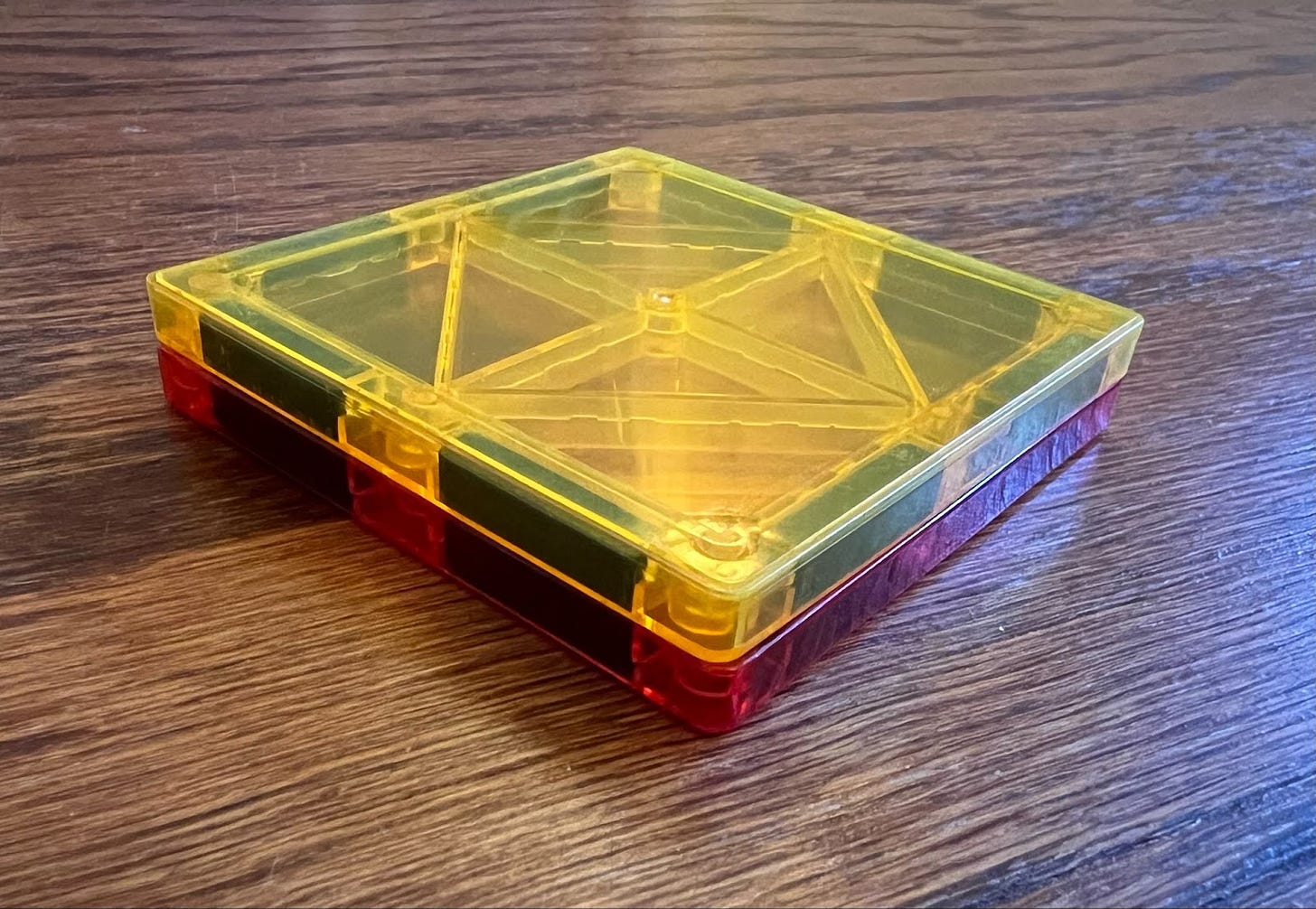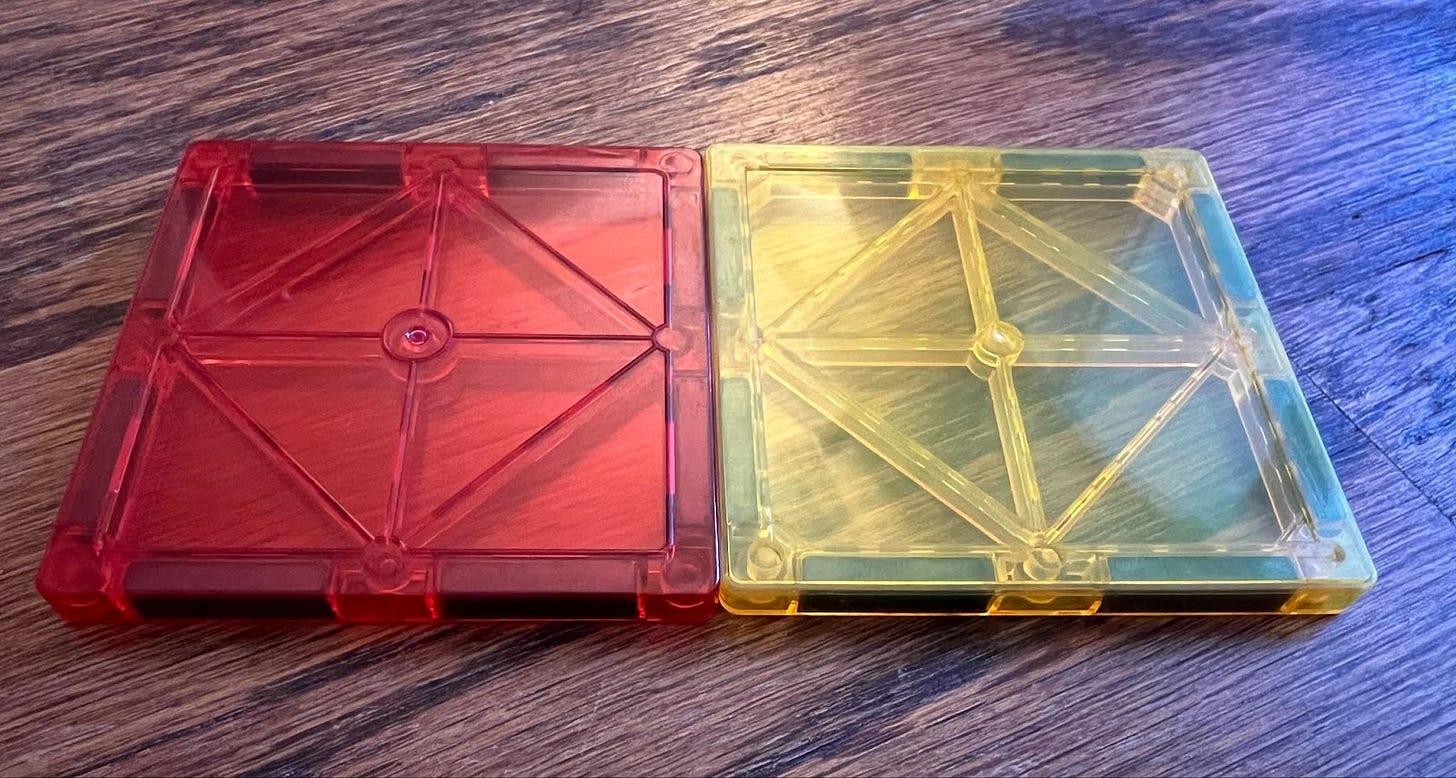Can You Figure Out How Magna-Tiles Work?
Sure, they have magnets inside. But arranging these magnets so the tiles always stick nicely together is a puzzle-worthy matter.
Welcome to Fiddler on the Proof! The Fiddler is the spiritual successor to FiveThirtyEight’s The Riddler column, which ran for eight years under the stewardship of myself and Ollie Roeder.
Each week, I present mathematical puzzles intended to both challenge and delight you. Beyond these, I also hope to share occasional writings about the broader mathematical and puzzle communities.
Puzzles come out Friday mornings (8 a.m. Eastern time). Most can be solved with careful thought, pencil and paper, and the aid of a calculator. Many include “extra credit,” where the analysis gets particularly hairy or where you might turn to a computer for assistance.
I’ll also give a shoutout to 🎻 one lucky winner 🎻 of the previous week’s puzzle, chosen randomly from among those who submit their solution before 11:59 p.m. the Monday after that puzzle was released. I’ll do my best to read through all the submissions and give additional shoutouts to creative approaches or awesome visualizations, the latter of which could receive 🎬 Best Picture Awards 🎬.
This Week’s Fiddler
My kids love Magna-Tiles. After some time playing around with them myself, I began to appreciate how they always seem to stick together, regardless of how they are rotated—a property I wouldn’t typically associate with magnets.
Every magnet has a north pole and a south pole. If you have two magnets and put their two north poles together, they repel. But rotate one of the magnets, and now you have a north pole near a south pole, so they’ll attract.
But Magna-Tiles are somehow impervious to rotation. Put one square tile on top of another, as shown in the photo below, and they stick together very well. Rotate one of the squares 90 degrees, they still stick. Flip one over, they still stick.
The tiles even stick together (though not as strongly) when placed side by side. Again, rotating or flipping a tile results in the same attraction.
Clearly, the eight magnets embedded along each square’s perimeter must be very cleverly oriented.
Consider the diagram below, which shows eight magnets along a square tile’s perimeter, labeled A through H in a counterclockwise manner. The tile lies in the x-y plane, and the z-axis is coming out of the screen toward you.
Given the square tiles’ imperviousness to rotation, what must the orientation of these eight magnets be? For each tile, you should describe the direction from its south pole to its north pole. (More than one answer is possible here.)
This Week’s Extra Credit
When you place one square Magna-Tile perfectly atop another, they stick together really well. Suppose each square has side length 1 unit and a thickness of 0.1 units.
We can model each tile’s eight magnets as monopoles that are either “north” or “south.” (Yes, I know magnetic monopoles don’t exist, but they’re a sufficient approximation for the following puzzle.) Let’s also assume these monopoles are points, rather than bars. They lie on each edge, one- and three-quarters of the way from one end to the other.
Assume that the energy between any two magnetic monopoles is q1q2/r, where r is the distance between them, and qi is +1 for “north” and -1 for “south.”
When one square lies in a plane directly above another (i.e., the planes are parallel and vertically separated by a distance of 0.1), the lowest-energy arrangement is when the top square is directly above the bottom one. This arrangement is stable, meaning a slight translation or rotation of either square won’t lower the energy. You should assign north vs. south polarity to each monopole on the bottom square based on your work in this week’s Fiddler. The corresponding monopoles on the top square should have the opposite polarity, so that the two squares stick together. If you did this correctly, you should be able to confirm that this arrangement has a magnetic energy between the squares of approximately -54.27. (Note: This figure does not include any magnetic energy within a square.)
Your Extra Credit challenge is to determine the stable arrangement with the next-lowest energy. Again, you should assume that the monopoles from one square and the other are vertically separated by 0.1, but that the squares are otherwise free to translate or rotate in their respective planes.
What is this next-best arrangement, and what is its corresponding magnetic energy between the squares?
(Hint: If you have any Magna-Tiles at home, try making different arrangements with one atop the other and seeing when they stick together.)
Making the Rounds
There’s so much more puzzling goodness out there, I’d be remiss if I didn’t share some of it here. This week, I’m sharing a visual puzzle from Matt Enlow. Here’s the spoiler-free version:
As always, feel free to discuss this puzzle and your approach in the comments below.
Want to Submit a Puzzle Idea?
Then do it! Your puzzle could be the highlight of everyone’s weekend. If you have a puzzle idea, shoot me an email. I love it when ideas also come with solutions, but that’s not a requirement.
Last Week’s Fiddler
Congratulations to the (randomly selected) winner from last week: 🎻 Daniel Franke 🎻 from Brookline, New Hampshire. I received 66 timely submissions, of which 50 were correct—good for a 76 percent solve rate.
Last week, you were waiting to be sorted into one of the four houses of Logwarts (a posh wizarding boarding school in the Scottish highlands) by an anthropomorphic sorting hat. The hat was a bit of a snob, and refused to sort two students in a row into the same house. If a student requested a certain house, but the previously sorted student had already been sorted into that same house, then the hat chose randomly from among the three remaining houses. Otherwise, the hat granted the student’s request.
You were standing 10th in line, and you made plans to request Graphindor house for yourself. As for the other students in line, you could assume that they had random preferences from among the four houses.
The first student stepped up and had a brief, quiet conversation with the hat. After a few moments, the hat proclaimed, “Graphindor!”
At this point, what was the probability that you would be sorted into Graphindor?
First off, kudos to the reader who responded, “I know this is not an answer to your question but id like to clarify that it is spelt griffindor.” I can’t tell if this was trolling or not, as not even J. K. Rowling spelled any house “griffindor.”
Anyway, back to the math. Let’s start by analyzing the line one student at a time. We’re told the first student went to Graphindor. That meant the second student definitely didn’t go to Graphindor. If their preference wasn’t Graphindor, then they went to their preferred house, with each of the remaining three being equally likely. If their preference was Graphindor, then they went to a random other house, again with each of the other three being equally likely. Thus, the second student had a 1-in-3 chance of being assigned to each of the non-Graphindor houses.
Things got a little more complicated with the third student in line. If they wanted Graphindor (with probability 1/4), it was theirs for the taking, since the second student definitely wasn’t Graphindor. But if they didn’t want Graphindor, there was a 1-in-3 chance they wanted the same house that the second student had just been assigned to, in which case there was a 1-in-3 chance they were randomly assigned to Graphindor. Putting this together, their probability of being assigned to Graphindor was 1/4 + (3/4)(1/3)(1/3), or 1/3.
We could keep going in this manner, proceeding carefully through the casework. However, a more generalized approach served you better beyond this point.
Suppose the probability that the kth student in line was sorted into Graphindor was pk. Could you use this values to determine pk+1, the probability that student k+1 was in Graphindor? Well, the only way for student k+1 to be in Graphindor was when student k wasn’t in Graphindor, which had probability 1−pk. Then, either student k+1 preferred Graphindor and got it or didn’t prefer it but was randomly assigned to it. Combining these cases again resulted in a probability of 1/3. Overall, that meant pk+1 = (1−pk)/3.
We already said p1 = 1. According to our formula, p2 = (1−p1)/3 = (1−1)/3 = 0. This confirmed what we already knew—that the second student couldn’t ever be a Graphindor. Let’s keep going!
p1 = 1
p2 = (1−p1)/3 = (1−1)/3 = 0
p3 = (1−p2)/3 = (1−0)/3 = 1/3 ≈ 33.3 percent
p4 = (1−p3)/3 = (1−1/3)/3 = 2/9 ≈ 22.2 percent
p5 = (1−p4)/3 = (1−2/9)/3 = 7/27 ≈ 25.9 percent
p6 = (1−p5)/3 = (1−7/27)/3 = 20/81 ≈ 24.7 percent
p7 = (1−p6)/3 = (1−20/81)/3 = 61/243 ≈ 25.1 percent
p8 = (1−p7)/3 = (1−182/729)/3 = 182/729 ≈ 24.97 percent
p9 = (1−p8)/3 = (1−547/2187)/3 = 547/2187 ≈ 25.01 percent
You might have been tempted to continue and calculate p10 = 1640/6561, but that wasn’t your next move. Standing 10th in line, you were unlike the students in front of you because you knew your preference was Graphindor, rather than a random house among the four. As long as the student in front of you didn’t wind up in Graphindor, then you were set.
That meant your probability of being in Graphindor—and the answer to the puzzle—was 1−p9, which came to 1640/2187, or about 74.98857 percent.
Before moving on, it’s worth taking a closer look at the list of probabilities above, which exhibited some neat patterns.
They appeared to converge to 1/4, with every other term (p1, p3, p5, p7, etc.) being greater than 1/4 and the remaining terms (p2, p4, p6, p8, etc.) being less than 1/4. Meanwhile, the numerators exhibited a pattern of their own. Starting with p3, the numerators alternated between being one less than three times greater than the previous numerator and one more than three times greater than the previous numerator.
To explain these patterns, suppose we defined a according to the equation pk = 1/4 + a. Then pk+1 = (1−pk)/3 = (1−1/4−a)/3 = (3/4−a)/3 = 1/4 − a/3. In other words, the difference between successive probabilities and 1/4 always shrank by a factor of three while flip-flopping on either side of 1/4—just as we noticed!
Last Week’s Extra Credit
Congratulations to the (randomly selected) winner from last week: 🎻 David Cohen 🎻 from Silver Spring, Maryland. I received 27 timely submissions, of which 22 were correct—good for an 81 percent solve rate.
Instead of being 10th in line, now you were Nth in line, where N was some value much greater than 10. Because so many students were being sorted in front of you, you decided to take a nap. You woke up without any idea of how long you were out—it could have been a second, or it could have been an hour, you just weren’t sure. It still wasn’t your turn to be sorted yet, but you saw a student wearing the hat. After a brief moment, the hat shouted, “Graphindor!”
To be clear, when you woke up, the student being sorted was anywhere from first in line to immediately before you in line with equal probability.
Suppose the answer to last week’s Fiddler was p (which we now know was 1640/2187). What was the smallest value of N such that your probability of being sorted into Graphindor was greater than p?
Keep reading with a 7-day free trial
Subscribe to Fiddler on the Proof to keep reading this post and get 7 days of free access to the full post archives.








